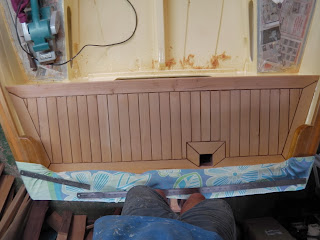The result looks good to me and so I have made a start on the fore deck. The next photo shows the marking out for the pieces around the mast hole and samson post.
Before I cut the plywood deck I made a template from strips of scrap ply stuck together with hot melt glue. Fortunately I kept the side pieces and was able to reuse them to make templates of the margin planks at the sides. Here are the templates on the port side. These planks have to be in two pieces because my planking timber isn't wide enough to fit the curved shape. The joint is in the sunlight above the samson post.
Having cut all the pieces for the margin and the mitred pieces for the mast hole and samson post surrounds I started gluing them in place. This is a bit tricky because the planks tend to slip about on the epoxy. I'm using pavers to hold the planks down and being very watchful for signs of slippage until the epoxy begins to go off. We are having a run of 30+ degree days at the moment and so this doesn't take too long!
There are still two pieces of the side planks to add but, as you can see, the pavers get a bit crowded. Tomorrow I will glue them in and start filling in the space in the middle.







